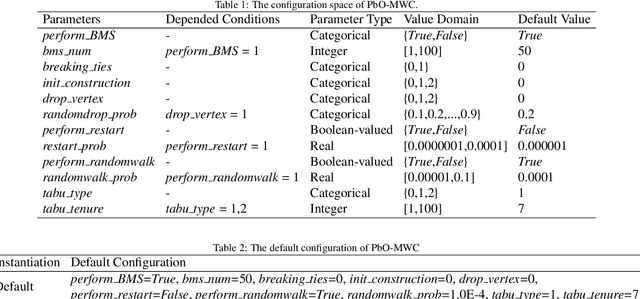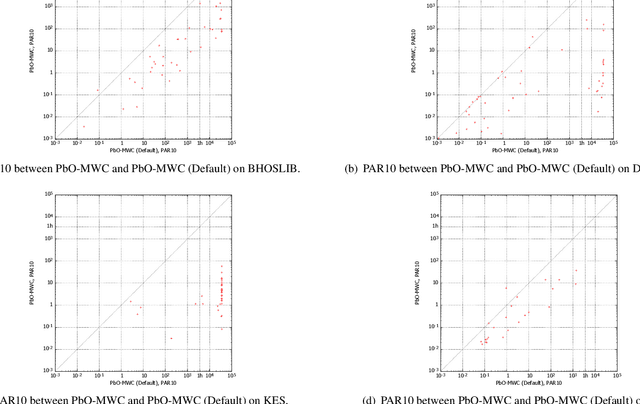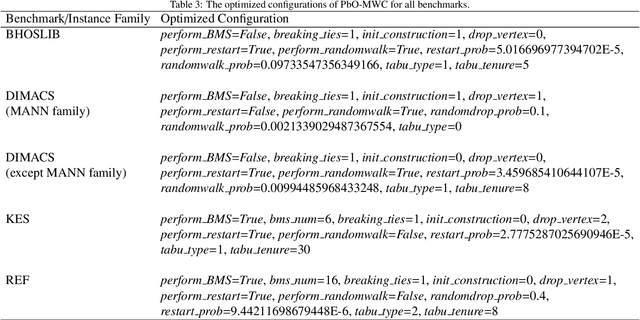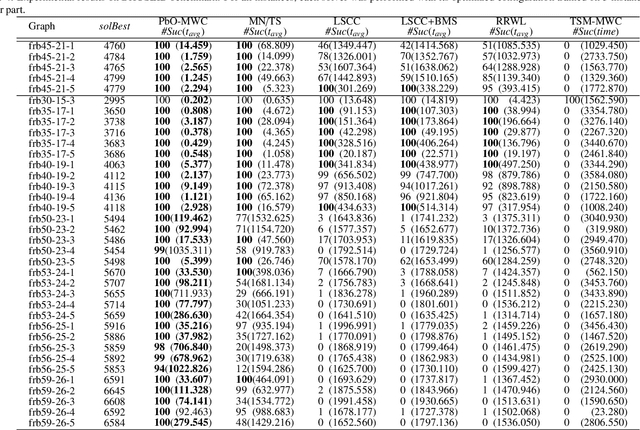Yi Chu
AutoPBO: LLM-powered Optimization for Local Search PBO Solvers
Sep 04, 2025Abstract:Pseudo-Boolean Optimization (PBO) provides a powerful framework for modeling combinatorial problems through pseudo-Boolean (PB) constraints. Local search solvers have shown excellent performance in PBO solving, and their efficiency is highly dependent on their internal heuristics to guide the search. Still, their design often requires significant expert effort and manual tuning in practice. While Large Language Models (LLMs) have demonstrated potential in automating algorithm design, their application to optimizing PBO solvers remains unexplored. In this work, we introduce AutoPBO, a novel LLM-powered framework to automatically enhance PBO local search solvers. We conduct experiments on a broad range of four public benchmarks, including one real-world benchmark, a benchmark from PB competition, an integer linear programming optimization benchmark, and a crafted combinatorial benchmark, to evaluate the performance improvement achieved by AutoPBO and compare it with six state-of-the-art competitors, including two local search PBO solvers NuPBO and OraSLS, two complete PB solvers PBO-IHS and RoundingSat, and two mixed integer programming (MIP) solvers Gurobi and SCIP. AutoPBO demonstrates significant improvements over previous local search approaches, while maintaining competitive performance compared to state-of-the-art competitors. The results suggest that AutoPBO offers a promising approach to automating local search solver design.
Enhancing Open RAN Digital Twin Through Power Consumption Measurement
Jul 01, 2025Abstract:The increasing demand for high-speed, ultra-reliable and low-latency communications in 5G and beyond networks has led to a significant increase in power consumption, particularly within the Radio Access Network (RAN). This growing energy demand raises operational and sustainability challenges for mobile network operators, requiring novel solutions to enhance energy efficiency while maintaining Quality of Service (QoS). 5G networks are evolving towards disaggregated, programmable, and intelligent architectures, with Open Radio Access Network (O-RAN) spearheaded by the O-RAN Alliance, enabling greater flexibility, interoperability, and cost-effectiveness. However, this disaggregated approach introduces new complexities, especially in terms of power consumption across different network components, including Open Radio Units (RUs), Open Distributed Units (DUs) and Open Central Units (CUs). Understanding the power efficiency of different O-RAN functional splits is crucial for optimising energy consumption and network sustainability. In this paper, we present a comprehensive measurement study of power consumption in RUs, DUs and CUs under varying network loads, specifically analysing the impact of Physical resource block (PRB) utilisation in Split 8 and Split 7.2b. The measurements were conducted on both software-defined radio (SDR)-based RUs and commercial indoor and outdoor RU, as well as their corresponding DU and CU. By evaluating real-world hardware deployments under different operational conditions, this study provides empirical insights into the power efficiency of various O-RAN configurations. The results highlight that power consumption does not scale significantly with network load, suggesting that a large portion of energy consumption remains constant regardless of traffic demand.
TalkUp: A Novel Dataset Paving the Way for Understanding Empowering Language
May 23, 2023



Abstract:Empowering language is important in many real-world contexts, from education to workplace dynamics to healthcare. Though language technologies are growing more prevalent in these contexts, empowerment has not been studied in NLP, and moreover, it is inherently challenging to operationalize because of its subtle, implicit nature. This work presents the first computational exploration of empowering language. We first define empowerment detection as a new task, grounding it in linguistic and social psychology literature. We then crowdsource a novel dataset of Reddit posts labeled for empowerment, reasons why these posts are empowering to readers, and the social relationships between posters and readers. Our preliminary analyses show that this dataset, which we call TalkUp, can be used to train language models that capture empowering and disempowering language. More broadly, as it is rich with the ambiguities and diverse interpretations of real-world language, TalkUp provides an avenue to explore implication, presuppositions, and how social context influences the meaning of language.
Improving the Performance of Stochastic Local Search for Maximum Vertex Weight Clique Problem Using Programming by Optimization
Feb 27, 2020



Abstract:The maximum vertex weight clique problem (MVWCP) is an important generalization of the maximum clique problem (MCP) that has a wide range of real-world applications. In situations where rigorous guarantees regarding the optimality of solutions are not required, MVWCP is usually solved using stochastic local search (SLS) algorithms, which also define the state of the art for solving this problem. However, there is no single SLS algorithm which gives the best performance across all classes of MVWCP instances, and it is challenging to effectively identify the most suitable algorithm for each class of MVWCP instances. In this work, we follow the paradigm of Programming by Optimization (PbO) to develop a new, flexible and highly parametric SLS framework for solving MVWCP, combining, for the first time, a broad range of effective heuristic mechanisms. By automatically configuring this PbO-MWC framework, we achieve substantial advances in the state-of-the-art in solving MVWCP over a broad range of prominent benchmarks, including two derived from real-world applications in transplantation medicine (kidney exchange) and assessment of research excellence.
An Optical Frontend for a Convolutional Neural Network
Jan 14, 2019



Abstract:The parallelism of optics and the miniaturization of optical components using nanophotonic structures, such as metasurfaces present a compelling alternative to electronic implementations of convolutional neural networks. The lack of a low-power optical nonlinearity, however, requires slow and energy-inefficient conversions between the electronic and optical domains. Here, we design an architecture which utilizes a single electrical to optical conversion by designing a free-space optical frontend unit that implements the linear operations of the first layer with the subsequent layers realized electronically. Speed and power analysis of the architecture indicates that the hybrid photonic-electronic architecture outperforms sole electronic architecture for large image sizes and kernels. Benchmarking of the photonic-electronic architecture on a modified version of AlexNet achieves a classification accuracy of 87% on images from the Kaggle Cats and Dogs challenge database.
 Add to Chrome
Add to Chrome Add to Firefox
Add to Firefox Add to Edge
Add to Edge